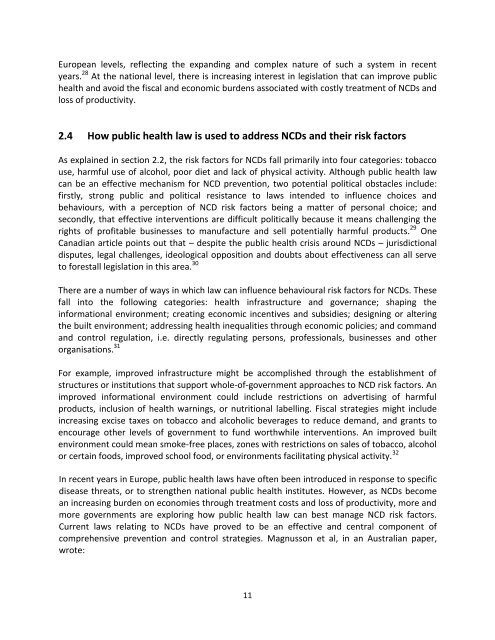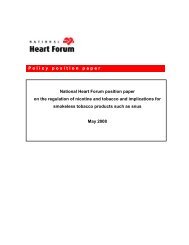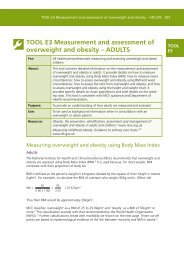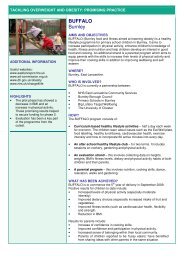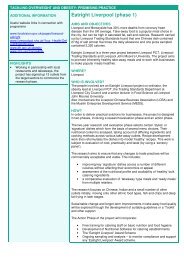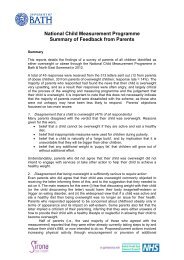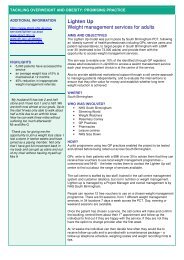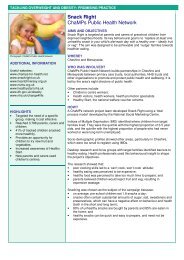Public Health Law and Non-communicable Diseases - UK Health Forum
Public Health Law and Non-communicable Diseases - UK Health Forum
Public Health Law and Non-communicable Diseases - UK Health Forum
You also want an ePaper? Increase the reach of your titles
YUMPU automatically turns print PDFs into web optimized ePapers that Google loves.
European levels, reflecting the exp<strong>and</strong>ing <strong>and</strong> complex nature of such a system in recent<br />
years. 28 At the national level, there is increasing interest in legislation that can improve public<br />
health <strong>and</strong> avoid the fiscal <strong>and</strong> economic burdens associated with costly treatment of NCDs <strong>and</strong><br />
loss of productivity.<br />
2.4 How public health law is used to address NCDs <strong>and</strong> their risk factors<br />
As explained in section 2.2, the risk factors for NCDs fall primarily into four categories: tobacco<br />
use, harmful use of alcohol, poor diet <strong>and</strong> lack of physical activity. Although public health law<br />
can be an effective mechanism for NCD prevention, two potential political obstacles include:<br />
firstly, strong public <strong>and</strong> political resistance to laws intended to influence choices <strong>and</strong><br />
behaviours, with a perception of NCD risk factors being a matter of personal choice; <strong>and</strong><br />
secondly, that effective interventions are difficult politically because it means challenging the<br />
rights of profitable businesses to manufacture <strong>and</strong> sell potentially harmful products. 29 One<br />
Canadian article points out that – despite the public health crisis around NCDs – jurisdictional<br />
disputes, legal challenges, ideological opposition <strong>and</strong> doubts about effectiveness can all serve<br />
to forestall legislation in this area. 30<br />
There are a number of ways in which law can influence behavioural risk factors for NCDs. These<br />
fall into the following categories: health infrastructure <strong>and</strong> governance; shaping the<br />
informational environment; creating economic incentives <strong>and</strong> subsidies; designing or altering<br />
the built environment; addressing health inequalities through economic policies; <strong>and</strong> comm<strong>and</strong><br />
<strong>and</strong> control regulation, i.e. directly regulating persons, professionals, businesses <strong>and</strong> other<br />
organisations. 31<br />
For example, improved infrastructure might be accomplished through the establishment of<br />
structures or institutions that support whole-of-government approaches to NCD risk factors. An<br />
improved informational environment could include restrictions on advertising of harmful<br />
products, inclusion of health warnings, or nutritional labelling. Fiscal strategies might include<br />
increasing excise taxes on tobacco <strong>and</strong> alcoholic beverages to reduce dem<strong>and</strong>, <strong>and</strong> grants to<br />
encourage other levels of government to fund worthwhile interventions. An improved built<br />
environment could mean smoke-free places, zones with restrictions on sales of tobacco, alcohol<br />
or certain foods, improved school food, or environments facilitating physical activity. 32<br />
In recent years in Europe, public health laws have often been introduced in response to specific<br />
disease threats, or to strengthen national public health institutes. However, as NCDs become<br />
an increasing burden on economies through treatment costs <strong>and</strong> loss of productivity, more <strong>and</strong><br />
more governments are exploring how public health law can best manage NCD risk factors.<br />
Current laws relating to NCDs have proved to be an effective <strong>and</strong> central component of<br />
comprehensive prevention <strong>and</strong> control strategies. Magnusson et al, in an Australian paper,<br />
wrote:<br />
11


